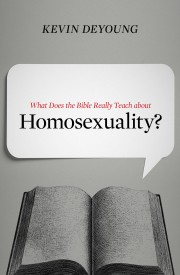Reviewed by Fred G. Zaspel
Each generation of Christians is called to be faithful, and it seems that each generation has its own issues where that faithfulness will be tested. The issue for our day – a genuinely defining issue – is homosexuality. I cannot imagine a context in western culture where a Christian will not need to speak to this issue at some point, and so part of the faithfulness required of us is to understand clearly – so we may proclaim clearly – what Scripture says about it. It is to this end that Kevin DeYoung has written his timely book, What Does the Bible Really Teach about Homosexuality?, and it just may be the best book on the subject to distribute to your congregation. It is brief, packed, clear and to the point, and it reflects a close acquaintance with the debate as it is shaped today.
Survey
DeYoung divides his discussion in to two major sections. Part 1 surveys the biblical teaching on the subject, examining all the major passages that address the subject in light of contemporary revisionists’ claims. He wisely begins with Genesis 1-2 in order to understand human sexuality rightly in its created design. His examination of this passage, especially in light of Jesus’ handling of the same – “from the beginning God made them male and female” – grounds and shapes his entire discussion remarkably well. He then demonstrates that Genesis 19 (Sodom and Gomorrah) will not allow an interpretation that does not understand homosexuality as at least part of the sin for which the cities are condemned. Likewise, Moses’ description of homosexuality as an “abomination” to God (Leviticus 18:22; 20:13) will not allow us to dismiss the condemnation of it as merely part of an obsolete Old Covenant.
DeYoung next turns to Romans 1 and notes the apostle’s emphasis that homosexuality is “against nature” and further observes that “the fact that Paul singles out homosexual relations as a conspicuous example of the human heart suppressing the truth and turning from God suggests that we must not soft-pedal as no big deal what the Bible underlines as particularly egregious rebellion.”
Finally, he examines the New Testament vocabulary of homosexuality – malakoi and arsenokoitai (1 Corinthians 6:9; 1 Timothy 1:10), the latter term against its likely origins in the Septuagint of Leviticus. His discussion demonstrates simply and clearly that Paul’s condemnation is not of “exploitive” forms of homosexuality only but of homosexual activity itself.
DeYoung devotes Part 2 of his book to answering the following contemporary objections:
- “The Bible Hardly Ever Mentions Homosexuality”
- “Not That Kind of Homosexuality”
- “What about Gluttony and Divorce?”
- “The Church Is Supposed to Be a Place for Broken People”
- “You’re on the Wrong Side of History”
- “It’s Not Fair”
- “The God I Worship Is a God of Love”
There are of course other questions DeYoung could have addressed, but these are the most prominent, and his answers are consistently crisp and to the point.
To round out his discussion a bit DeYoung attaches three appendices:
- Appendix 1: What about Same-Sex Marriage?
- Appendix 2: Same-Sex Attraction: Three Building Blocks
-
Appendix 3: The Church and Homosexuality: Ten Commitments
Reflections
This debate today is a heated one. The societal changes our generation has witnessed in this regard are staggering. We needn’t worry, of course, that we Christians are on “the wrong side” of history. Scripture tells us what the winning side is and teaches us to look ahead with a great sense of optimism. What matters is that we be faithful until then. And so ultimately the only question that matters in this debate is, “What does the Bible really say?” This is DeYoung’s chosen title, and it is the strength of his book. He shows a good grasp of the relevant passages, and his handling of the pertinent exegetical details is clear, on target, and concise, treating all the major passages with relative thoroughness in under 70 pages (Part 1).
DeYoung has also kept track of the debate as it has been shaped in our day, and the “Objections” he addresses in Part 2 are well-chosen and his answers plain and well-informed. These are questions for which Christians need clear answers, and DeYoung serves the church well on this score also. His answers throughout Part 2 and the Appendices are pastorally sensitive also, and you may distribute his book without fear of offense.
A reviewer at this point might point out “What I wish he had said” and suggest that DeYoung had addressed some additional exegetical or historical detail, or perhaps this or that aspect of today’s debate. I felt that urge at only a couple points in the book. There is always more that could be said. Indeed, there are plenty of other books and essays you can read to sort through the endless details and disputes, and DeYoung cites them occasionally and notes them for us in his Annotated Bibliography. But he does not set out in this book to say everything. He writes briefly and simply to equip the church with reference to one of today’s defining social issues. In my judgment he accomplishes his goal admirably.
The church of our generation deserves a fresh restatement of the biblical teaching on homosexuality, and this is the book you will want to give those who are willing to hear it.
Fred G. Zaspel is Executive Editor here at Books At a Glance.
Editor’s Note: Here is a 36-page free sample and also a free Study Guide that accompanies the book.
You may want to check out our interview with Kevin on his new book here.
